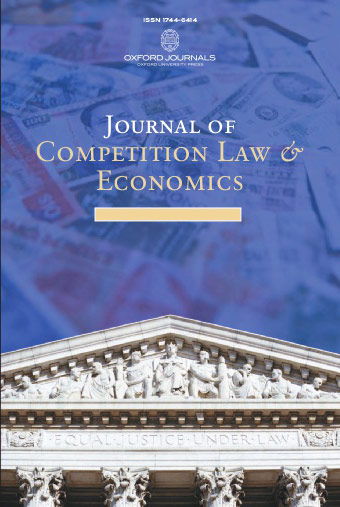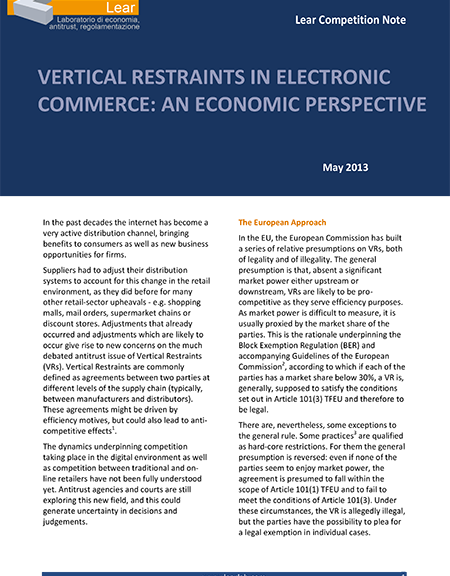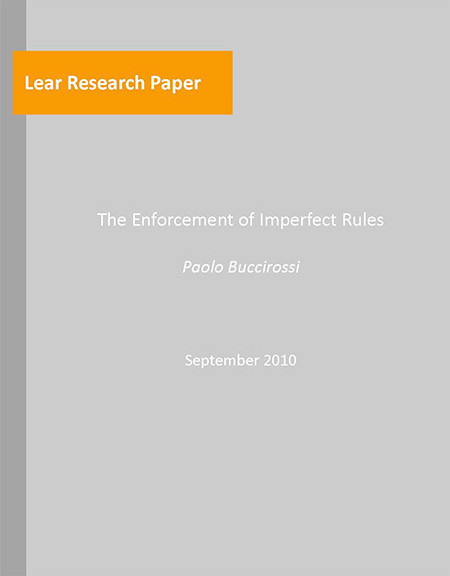This paper discusses whether, when manufacturers choose to adopt a selective distribution system, vertical restraints imposed on electronic commerce (e-commerce) may work in the interest of consumers or have anticompetitive consequences that require an antitrust intervention. The paper presents the basic economic concepts that apply to vertical restraints, and identifies the efficiency reasons and the anticompetitive effects that may motivate their adoption. Then, the relevant economic literature is surveyed in order to understand how e-commerce influences retail competition, taking into account its impact on search costs, distribution costs, and information asymmetry. The paper examines the legal treatment of vertical restraints on e-commerce in the case of selective distribution; it summarizes the position expressed by the European Commission in the Block Exemption Regulation and the accompanying guidelines, and then discusses some cases decided by National Competition Authorities, National Courts, and the European Courts. From this overview emerges the risk that the antitrust analysis of vertical restraints on e-commerce in selective distribution systems may be guided by presumptions that do not have solid economic grounds. The paper argues that it is unwise to adopt a formal approach for the legal assessment of these vertical restraints and calls for a more economic effect-based approach.
Archives
Vertical Restraints in Electronic Commerce: an economic perspective
Vertical Restraints (VRs) are commonly defined as agreements between two parties at different levels of the supply chain. These agreements might be driven by efficiency reasons but could also lead to anti-competitive effects. In the past decade, the development of electronic commerce has raised new issues concerning the dynamics underpinning competition in the digital environment as well as competition between traditional and on-line retailers. Through the analysis of the Pierre Fabre Dermo-Cosmétique case, this note seeks to outline a different approach in the assessment of VRs in electronic markets and analyses some critical issues that are often neglected.
Price Relationship Agreements: economic analysis and implications for competition
Price Relationship Agreements (PRAs) are agreements linking one supplier’s price to those charged to other customers or by competitors. Firms adopt PRAs for many different reasons and the competitive effects of these agreements may vary substantially. This note summarizes the main findings of a comprehensive literature review of PRAs, bringing together different economic theories of harm and efficiency motivations, and provides some policy implications.
Can ‘Fair’ Prices Be Unfair? A Review of Price Relationship Agreements
The report, prepared for the OFT by LEAR, examines the various forms these agreements can take, their potential benefits and anti-competitive effects, drawing on economic literature and relevant case law. The OFT will present the findings today at a joint workshop held by the US Federal Trade Commission and Department of Justice on the implications for antitrust policy and enforcement of ‘most-favoured nation’ (MFN) clauses, which are a type of price relationship agreement.
The report suggests that while some types of price relationship agreements could be attractive to buyers, they could also have a softening effect on competition. For example, shoppers offered a ‘lowest price’ guarantee may not bother to shop around as much as they would otherwise, thus reducing the downward pressure on prices. Furthermore, if a rival of a ‘lowest price’ retailer knows that any price reduction will quickly be matched or beaten, the incentive to lower prices may be reduced.
The Enforcement of Imperfect Rules
This paper examines the optimal sanction for rules that are imperfect in that they are either overinclusive, as they prohibit an action that in some circumstances is beneficial, or underinclusive as they allow agents to undertake alternative conducts that are harmful, or both. The paper clarifies why this notion of imperfection divers from the notion of over- and underdeterrence and from that of legal errors. Finally it shows that when rules are imperfect the optimal sanction is lower than the optimal sanction for a perfect rule, both if the rule is overinclusive and if it is underinclusive.
A Search Model Where Consumers Choose Quantity Based on Expected Price
I describe a price game in which consumers face search costs and base their quantity decision on the expected price. Because of search costs, the choice of the firm they will buy from is described by a random process. I show that the expected equilibrium price is above the monopoly price. This result does not change if demand comes from a small share of perfectly informed consumers with zero search costs.
Published in The Journal of Industrial Economics, December 2003, Vol. LI, n. 4, pp. 427-32.
Access to an Essential Facility: Efficient Component Pricing Rule or Unrestricted Private Property Rights
In this paper we compare the access to an essential facility in two different property rights regimes. In one of them, the owner of the facility has a full private property right. In the other, access is regulated according to the efficient component pricing rule. Proponents of the second regime claim that this rule is efficient, for it forecloses the complementary market only to inefficient producers. We prove that the two legal frameworks are equivalent if we do not consider the possibility of the transfer of the property right and that if this is allowed the efficient component pricing rule might exclude efficient suppliers.






